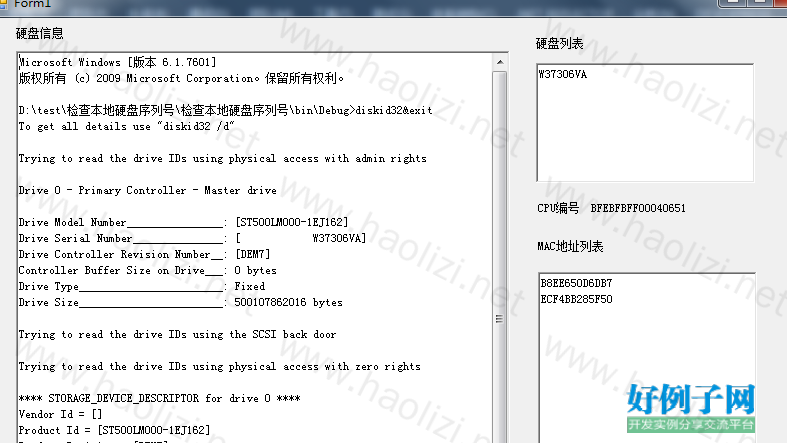实例介绍
【实例截图】

【核心代码】
using System;
using System.Collections.Generic;
using System.ComponentModel;
using System.Data;
using System.Diagnostics;
using System.Drawing;
using System.Linq;
using System.Management;
using System.Net.NetworkInformation;
using System.Runtime.InteropServices;
using System.Text;
using System.Windows.Forms;
namespace 检查本地硬盘序列号
{
public partial class Form1 : Form
{
/// <summary>
/// 获取磁盘逻辑序列号
/// </summary>
/// <param name="lpRootPathName">欲获取信息的那个卷的根路径 </param>
/// <param name="lpVolumeNameBuffer">用于装载卷名(卷标)的一个字串 </param>
/// <param name="nVolumeNameSize">lpVolumeNameBuffer字串的长度 </param>
/// <param name="lpVolumeSerialNumber">用于装载磁盘卷序列号的变量 </param>
/// <param name="lpMaximumComponentLength">指定一个变量,用于装载文件名每一部分的长度。例如,在“c:\component1\component2.ext”的情况下,它就代表component1或component2名称的长度 .</param>
/// <param name="lpFileSystemFlags">用于装载一个或多个二进制位标志的变量。对这些标志位的解释如下:
/// FS_CASE_IS_PRESERVED 文件名的大小写记录于文件系统
/// FS_CASE_SENSITIVE 文件名要区分大小写
/// FS_UNICODE_STORED_ON_DISK 文件名保存为Unicode格式
/// FS_PERSISTANT_ACLS 文件系统支持文件的访问控制列表(ACL)安全机制
/// FS_FILE_COMPRESSION 文件系统支持逐文件的进行文件压缩
/// FS_VOL_IS_COMPRESSED 整个磁盘卷都是压缩的 </param>
/// <param name="lpFileSystemNameBuffer">指定一个缓冲区,用于装载文件系统的名称(如FAT,NTFS以及其他)</param>
/// <param name="nFileSystemNameSize">lpFileSystemNameBuffer字串的长度</param>
/// <returns></returns>
[DllImport("Kernel32.dll", CharSet = CharSet.Auto)]
public static extern bool GetVolumeInformation(
string lpRootPathName,
string lpVolumeNameBuffer,
int nVolumeNameSize,
ref int lpVolumeSerialNumber,
int lpMaximumComponentLength,
int lpFileSystemFlags,
string lpFileSystemNameBuffer,
int nFileSystemNameSize);
public Form1()
{
InitializeComponent();
label4.Text = CpuID();
List<string> disklist = GetHardDiskIDList();
if (disklist != null)
for (int i = 0; i < disklist.Count; i )
{
richTextBox2.Text = disklist[i] "\r\n";
}
List<string> maclist = GetMacList();
if(maclist !=null)
for (int i = 0; i < maclist.Count; i )
{
richTextBox3.Text = maclist[i] "\r\n";
}
}
/// <summary>
///
/// </summary>
private object _hardDiskIDThrObj = new object();
/// <summary>
///
/// </summary>
private List<string> _hdSerList = null;
public List<string> GetHardDiskIDList()
{
lock (_hardDiskIDThrObj)
{
if (_hdSerList != null)
{
return _hdSerList.ToList();
}
string input = "diskid32";
string output = string.Empty;
using (Process p = new Process())
{
p.StartInfo.FileName = "cmd.exe";
p.StartInfo.UseShellExecute = false;//是否使用操作系统shell启动
p.StartInfo.RedirectStandardInput = true;//接受来自调用程序的输入信息
p.StartInfo.RedirectStandardOutput = true;//由调用程序获取输出信息
p.StartInfo.RedirectStandardError = true;//重定向标准错误输出
p.StartInfo.CreateNoWindow = true;//不显示程序窗口
p.StartInfo.ErrorDialog = false;
p.Start();//启动程序
//向cmd窗口发送输入信息
p.StandardInput.WriteLine(input "&exit");
p.StandardInput.AutoFlush = true;
//p.StandardInput.WriteLine("exit");
//向标准输入写入要执行的命令。这里使用&是批处理命令的符号,表示前面一个命令不管是否执行成功都执行后面(exit)命令,如果不执行exit命令,后面调用ReadToEnd()方法会假死
//同类的符号还有&&和||前者表示必须前一个命令执行成功才会执行后面的命令,后者表示必须前一个命令执行失败才会执行后面的命令
//获取cmd窗口的输出信息
output = p.StandardOutput.ReadToEnd();
p.WaitForExit(100);//等待程序执行完退出进程
p.Close();
}
if (output != string.Empty)
{
this.richTextBox1.Text = output.ToString();
List<string> hdSerList = new List<string>();
string val = string.Empty;
int index = 0;
string[] lines = output.Split(new string[] { "\r\n" }, StringSplitOptions.RemoveEmptyEntries);
foreach (string line in lines)
{
if (line.IndexOf("Serial Number") < 0)
{
continue;
}
index = line.IndexOf(':');
if (index < 0)
{
index = line.IndexOf('=');
if (index < 0)
{
continue;
}
}
if (line.Length < index 1)
{
continue;
}
val = line.Substring(index 1).Trim().Trim('[').Trim(']').Trim();
if (val == "0000_0000_0000_0000." || val == "00000_00_000000_00.0")
{
continue;
}
if (!string.IsNullOrEmpty(val) && !hdSerList.Contains(val))
{
hdSerList.Add(val);
}
}
if (hdSerList.Count < 1)
{
hdSerList.Add(GetdiskID());
}
_hdSerList = hdSerList;
}
else
{
_hdSerList = new List<string>();
_hdSerList.Add(GetdiskID());
}
return _hdSerList.ToList();
}
}
/// <summary>
/// 获取硬盘ID
/// </summary>
/// <returns></returns>
private string GetdiskID()
{
try
{
const int MAX_FILENAME_LEN = 256;
int retVal = 0;
int a = 0;
int b = 0;
string str1 = null;
string str2 = null;
GetVolumeInformation(
@"C:\",
str1,
MAX_FILENAME_LEN,
ref retVal,
a,
b,
str2,
MAX_FILENAME_LEN);
return retVal.ToString("X2");
}
catch
{
return "00000000";
}
}
private static string _cpuID = string.Empty;
private static object _cpuIDThrObj = new object();
/// <summary>
/// 取CPU编号
/// </summary>
/// <param name="refresh">是否重新获取,默认否</param>
/// <returns></returns>
public static string CpuID(bool refresh = false)
{
lock (_cpuIDThrObj)
{
try
{
if (_cpuID != string.Empty && !refresh)
{
return _cpuID;
}
ManagementClass mc = new ManagementClass("Win32_Processor");
ManagementObjectCollection moc = mc.GetInstances();
foreach (ManagementObject mo in moc)
{
_cpuID = mo.Properties["ProcessorId"].Value.ToString();
return _cpuID;
}
_cpuID = string.Empty;
return _cpuID;
}
catch
{
_cpuID = string.Empty;
return _cpuID;
}
}
}
private static List<string> _macList = null;
/// <summary>
/// 获取本地Mac地址列表
/// </summary>
/// <returns></returns>
public static List<string> GetMacList()
{
if (_macList == null)
{
List<string> maclist = new List<string>();
try
{
NetworkInterface[] niArray = NetworkInterface.GetAllNetworkInterfaces();
if (niArray.Length < 1)
{
maclist = new List<string>();
}
else
{
foreach (NetworkInterface entity in niArray)
{
if (!entity.SupportsMulticast)
continue;
string mac = entity.GetPhysicalAddress().GetAddressBytes().ToHexString();
if (string.IsNullOrEmpty(mac))
continue;
maclist.Add(mac);
}
}
//return niArray.Select(p => p.GetPhysicalAddress().GetAddressBytes().ToHexString()).ToArray();
}
catch
{
maclist = new List<string>();
}
_macList = maclist;
}
return _macList.ToList();
}
}
public static class Extensions
{
/// <summary>
/// 将byte转换为Hex格式字符串
/// </summary>
/// <param name="source">源</param>
/// <param name="spl">分隔符</param>
/// <returns></returns>
public static string ToHexString(this byte[] source, string spl = "")
{
if (source == null || source.Length < 1)
return string.Empty;
spl = spl == null ? string.Empty : spl;
StringBuilder sb = new StringBuilder(source.Length * (2 spl.Length));
for (int i = 0; i < source.Length; i )
{
sb.Append(source[i].ToString("X2"));
if (i < source.Length - 1)
{
sb.Append(spl);
}
}
return sb.ToString();
}
}
}
标签: 检查本地硬盘序列号
小贴士
感谢您为本站写下的评论,您的评论对其它用户来说具有重要的参考价值,所以请认真填写。
- 类似“顶”、“沙发”之类没有营养的文字,对勤劳贡献的楼主来说是令人沮丧的反馈信息。
- 相信您也不想看到一排文字/表情墙,所以请不要反馈意义不大的重复字符,也请尽量不要纯表情的回复。
- 提问之前请再仔细看一遍楼主的说明,或许是您遗漏了。
- 请勿到处挖坑绊人、招贴广告。既占空间让人厌烦,又没人会搭理,于人于己都无利。
关于好例子网
本站旨在为广大IT学习爱好者提供一个非营利性互相学习交流分享平台。本站所有资源都可以被免费获取学习研究。本站资源来自网友分享,对搜索内容的合法性不具有预见性、识别性、控制性,仅供学习研究,请务必在下载后24小时内给予删除,不得用于其他任何用途,否则后果自负。基于互联网的特殊性,平台无法对用户传输的作品、信息、内容的权属或合法性、安全性、合规性、真实性、科学性、完整权、有效性等进行实质审查;无论平台是否已进行审查,用户均应自行承担因其传输的作品、信息、内容而可能或已经产生的侵权或权属纠纷等法律责任。本站所有资源不代表本站的观点或立场,基于网友分享,根据中国法律《信息网络传播权保护条例》第二十二与二十三条之规定,若资源存在侵权或相关问题请联系本站客服人员,点此联系我们。关于更多版权及免责申明参见 版权及免责申明



网友评论
我要评论